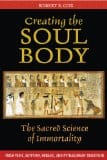
Creating the Soul Body: The Sacred Science of Immortality
, by Robert E. Cox
Inner Traditions, 9781594772214, 263 pp., 2008
Creating the Soul Body is largely unlike what I expected from the synopsis and title, I expected it to focus on the Soul, and perhaps reincarnation, but instead it takes another route altogether. The immortality in the title refers not to a physical immortality or a spiritual immortality dependant on reincarnation, but a mental/spiritual immortality in the sense of Enlightenment and Oneness with everything, though this notion was largely cast aside in favour of the theories of the knowledge it reveals. This book was also not in the least on the practical side, but a book purely of theory and information, and that made for an interesting read.
This immortality is often expressed in terms of spiritual importance, but Cox sets forth to “crack the code of the ancient spiritual science so that the science possessed by different cultures can be compared and evaluated in the light of modern empirical science.”1 He believes that ancient cultures, specifically the Vedic Hindu culture as well as the Egyptian culture and Hebrew culture, knew not only more about the way spiritual reality worked, but knew far more about the physical universe than we could believe, and that as a scientific culture we’re still catching up.
After the first third of the book is spent talking purely on spiritual systems and that enlightened souls have access to knowledge beyond their means, he begins to explore how this veiled religious language actually relates to physical science. He puts forth than ancient cultures knew such things as the speed of light, the size of the sun and the heliosphere, and even down to knowing Plank’s length. After he exhausts the Vedic sources (around the significance of the number thirty-three), he then switches to Egyptian and then Hebrew cultures, as I was reading the book, I felt this hurt his theories, that he had to search through different cultures to build upon his theory, rather than just work in one, or several in tandem.
As I read the book, I couldn’t help but get swept into his theories, in some cases beating him to the point, which fits the fact that he says: “No doubt, the ancient system is couched in religious-spiritual terms- but we can see that when it is interpreted properly, it has predictive power.”2 For example he says, based on an interesting take on symbolism, that the sun would be 1cmx10^11, when in actuality it is 1.3cmx10^11, which is a pretty good guess based on Vedic scripture.
Unfortunately for this predictive power, his math and numbers don’t add up the majority of the time. Once I finished reading the book, I double checked the math and numbers with Wikipedia, some handy textbooks and friends in appropriate fields, and found that much of what he put forth was just blatantly wrong. His symbolically proven size of the Plank length is off by four decimal places, and other “proofs” were just as wrong. In fact, out of what I managed to double check, only the size of the sun was right, the speed of light is arguably right, except he fails to mention the two units of measurement used to find the speed of light are subjective distances. The yojana for example is 6-15 km, and Cox merely picked the length of the yojana and nimesha that together would work out to the speed of light.
As I read the book, I found the theories very compelling, but a cursory exploration of the details proves that he didn’t get the numbers to add up. I thought while reading, that if the numbers added up, this book could be an amazing breakthrough, unfortunately the math seems all wrong, and this book only seems to be a disappointment.








